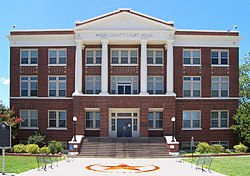Wood County, Texas
| Wood County, Texas | ||
|---|---|---|

The Wood County Courthouse in Quitman
|
||
|
||
 Location in the U.S. state of Texas |
||
 Texas's location in the U.S. |
||
| Founded | 1850 | |
| Seat | Quitman | |
| Largest city | Mineola | |
| Area | ||
| • Total | 696 sq mi (1,803 km2) | |
| • Land | 645 sq mi (1,671 km2) | |
| • Water | 50 sq mi (129 km2), 7.3% | |
| Population | ||
| • (2010) | 41,964 | |
| • Density | 65/sq mi (25/km²) | |
| Congressional districts | 1st, 5th | |
| Time zone | Central: UTC-6/-5 | |
| Website | www |
|
Wood County is a county located in the U.S. state of Texas. As of the 2010 census, the population was 41,964. Its county seat is Quitman. The county was named for George T. Wood, governor of Texas from 1847 to 1849.
The first documented European exploration of the territory that is now Wood County was by Pedro Vial, who was an explorer sent on expeditions by the Spanish governor of Texas. After an expedition to Santa Fe, Vial set out for Natchitoches in 1787, and in 1788, passed through the territory on his way back from there to San Antonio.
There is some archeological evidence to suggest the French had a trading post along Mill Race Creek near the site of the present day town of Hainsville. In addition, it is believed, in addition to the trading post, that the French may have had a fortification called Fort Ledout near Black Oak in the county. Both would have been in the 1710s, but aside from archeological evidence, little is known about possible French settlements in the county.
A major archeological discovery by a hunting party in 1887 southeast of Hainsville and north of Bromley resulted in the belief that indigenous peoples may have engaged in a battle among tribes or with the Spanish at some point. However, in spite of the discovery of numerous relics including a cross, tomahawk pieces, a Spanish coin, and several pieces of guns, no written evidence documents what may have occurred at the site.
Although some land grants were issued in the area, settlement was sparse until after the Texas Revolution. The first white settler was Martin Varner. He settled in the area near the southeast side of the present day settlement of Hainsville by 1824. The first organized settlement was at Webster in 1845.
In 1850, five years after Texas was annexed to the United States, the Legislature authorized the forming of the county from Van Zandt County. In 1849, residents of what was then Van Zandt County north of the Sabine River, petitioned the Legislature for the county to be reorganized. Reasons included that the majority of the population lived north of the river, and that travel to Jordan's Saline, then the county seat, was difficult in winter. Wood county was created and Van Zandt was reorganized with territory from adjacent counties.
Early industry included a number of sawmills, gritsmills, steam mills, and cotton gins. A jug factory operated north of the Big Sandy Creek in the 1850s. A second judge factory was built some years later near Holly Creek. Two brick kilns are known to have been located in the area of Winnsboro. A furniture company, Wigley Furniture Company, begain operating in Mineola in 1874. A cane and raw-hide bottom chair factory opened in 1886. Tie-cutting became a major industry in the county in the 1870s with the coming of the railroads. Pine Mills, Perryville, Ogburn, Merrimac, Peach, and Fouke got their start as sawmill towns.
...
Wikipedia

